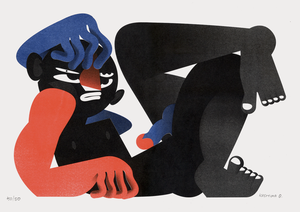
Cover, image source: artist, © Ursula Döbereiner
Notes
192 pages
Softcover
17 cm x 21 cm
123 color images
30 b&w images
Texts (German/English): Jutta von Zitzewitz and Volker Pantenburg
ISBN: 978-3-9812127-0-9
The catalog "frauen/hier/musik/paranoia/poster/spaces/UND/zuhause" ["women/here/music/paranoia/posters/spaces/AND/home"] by the Berlin artist Ursula Döbereiner is a comprehensive presentation of her work of the last 5 years.
The smallest meaningful unit in Ursula Döbereiner's work is the drawing. It is the means by which the artist illuminates the conditions of visual perception in times of the "iconic turn". Her profiles capture the afterglow that the multitude of media and other images affecting us daily leave on our retina – just before they disappear and are overwritten by new ones. Film stills, poster motifs, found and self-made photos, and images from the internet provide the material that feeds the pop-cultural repertoire of her ballpoint pen and computer drawings. As a visual "diary of an infantile society", they deconstruct the pictorial arsenal of a mass culture that assimilates private and collective longings in a rapacious cycle, shapes them and spits them out again, reproduced millions of times.
---
192 Seiten
Softcover
17 cm x 21 cm
123 farbige Abbildungen
30 schwarz-weiße Abbildungen
Texte (deutsch/english): Jutta von Zitzewitz, Volker Pantenburg
ISBN: 978-3-9812127-0-9
Der Katalog "frauen/hier/musik/paranoia/poster/spaces/UND/zuhause" der Berliner Künstlerin Ursula Döbereiner ist eine umfassende Darstellung ihres Werkes der letzten 5 Jahre.
Die kleinste bedeutungstragende Einheit in Ursula Döbereiners Werk ist die Zeichnung. Sie ist das Mittel, mit dem die Künstlerin die Bedingungen des Sehens in Zeiten des „Iconic Turn“ erhellt. Ihre Profile halten jenes Nachglimmen fest, das die Vielzahl der medialen und alltäglichen Images, die täglich auf uns einströmen, auf unserer Netzhaut hinterlassen – kurz bevor sie verlöschen und von neuem überschrieben werden. Filmstills, Postermotive, vorgefundene und selbst gemachte Fotos sowie Bilder aus dem Internet liefern das Material, das den popkulturellen Fundus ihrer Kugelschreiber- und Computerzeichnungen speist. Als visuelles „Tagebuch einer Infantilgesellschaft“ dekonstruieren sie das Bildarsenal einer Massenkultur, die private und kollektive Sehnsüchte in einem raubgierigen Kreislauf assimiliert, prägt und millionenfach reproduziert wieder ausspuckt.


























